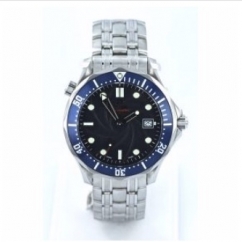Articles and News
Pre-Owned Jewelry Leads Secondhand Luxury Goods Market October 16, 2019 (0 comments)

New York, NY—It’s no secret the secondhand luxury market is exploding, and at present shows no signs of slowing down. Millennials are just as happy to rent their luxury or buy gently used versions of the brands they covet as to splurge for the new item. Left: An Omega Seamaster James Bond model, from preowned watch site Second Time Round.
Related: When Old Becomes New Again, Jewelers Profit Handsomely
Now luxury watch brands want in on the action, reports Luxury Daily. A growing number of luxury watchmakers such as Omega, Vacheron Constantin, and others, are launching their own brand-operated secondhand sales and services, grabbing some ownership of the lucrative pre-owned market.
“While certified pre-owned is a common practice in the automotive industry, it is expanding to personal luxury goods as watch houses debut authenticated vintage timepieces,” says Luxury Daily. The report cites findings from Bain that show the secondhand jewelry [and watch] business makes up the lion’s share of the pre-owned personal luxury goods market. The category has grown about 9% year on year since 2015, and in 2018 accounted for 80% of the total $24 billion secondhand market.
Read the full Luxury Daily report here.
Separately, new research from Boston Consulting Group and secondhand luxury platform Vestaire Collective may help the overall luxury industry more than harm it as initially expected, reports Luxury Daily. Resale is often one of the first ways for consumers to access and purchase luxury goods, with 71% gravitating towards items they can’t afford new. It also appeals to environmentally-conscious consumers.
The secondhand luxury market is expected to grow about 12% year on year, compared with 3% growth in the core luxury business, says the article.
Related: The Trend You Should Be Jumping On—Or At Least Seriously Considering
But another question looms: as discussed in this Centurion article, hot markets drive prices up, so if the cost of a used item gets to the point where it’s not much below its new version, something will give. Either secondhand consumers will slam their wallets shut until prices come back down, or brands will jack up prices of the new versions to a point where it’s not sustainable either. We’ve already seen what happens then: when Tiffany increased the price of its popular “Return To Tiffany” silver collection by nearly 400%, it very effectively shot itself in the balance sheet. When fewer consumers buy new, inventory in the secondhand luxury market will also dry up, as currently a significant portion of it comes from affluent shoppers who want to make room for their new purchases.
But that is still a future issue. Bain/Vestaire’s study shows the market is still in the upswing, and isn’t nearing a tipping point just yet.

The pre-owned Omega Seamaster shown above is not much of a bargain: only £18 ($23) less than the recommended retail price on UK resale platform SecondTimeRound.







